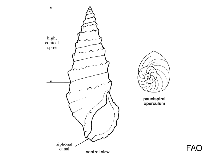Bittiolum varium (Pfeiffer, 1840)
Grass cerith| Native range | All suitable habitat | Point map | Year 2050 |

|
| This map was computer-generated and has not yet been reviewed. |
| Bittiolum varium AquaMaps Data sources: GBIF OBIS |
Upload your photos
Google image | No image available for this species;
drawing shows typical species in Cerithiidae.
Google image | No image available for this species;
drawing shows typical species in Cerithiidae.
Classification / Names Common names | Synonyms | CoL | ITIS | WoRMS
| Not assigned | Cerithiidae
Environment: milieu / climate zone / depth range / distribution range Ecología
Asociado a arrecife; rango de profundidad 0 - 11 m (Ref. 83435). Tropical; 38°N - 30°S, 98°E - 35°E (Ref. 83435)
Distribución Países | Áreas FAO | Ecosistemas | Ocurrencias, apariciones | Introducciones
Western Atlantic: Maryland to Brazil.
Length at first maturity / Tamaño / Peso / Age
Maturity: Lm ? range ? - ? cm Max length : 0.7 cm DL macho / no sexado; (Ref. 83435)
This species is found in offshore, intertidal and subtidal coral reefs, bays and coves, cienaga facies, reef lagoons, and drift, particularly in algae, ascidian, coral, diatoms, mud, rock, rubble, sand, seagrass, and shell habitats (Ref. 83934).
Life cycle and mating behavior Madurez | Reproducción | Puesta | Huevos | Fecundidad | Larva
Members of the order Neotaenioglossa are mostly gonochoric and broadcast spawners. Life cycle: Embryos develop into planktonic trocophore larvae and later into juvenile veligers before becoming fully grown adults.
Main reference
Referencias | Coordinador | Colaboradores
Vittor, B.A. 2001. (Ref. 8431)
IUCN Red List Status (Ref. 130435)
CITES status (Ref. 108899)
Not Evaluated
CMS (Ref. 116361)
Not Evaluated
Threat to humans
Human uses
| FishSource |
Herramientas
Más información
Países
Áreas FAO
Ecosistemas
Ocurrencias, apariciones
Introducciones
Stocks
Ecología
Dieta
componentes alimenticios
Áreas FAO
Ecosistemas
Ocurrencias, apariciones
Introducciones
Stocks
Ecología
Dieta
componentes alimenticios
Age/Size
Crecimiento
Length-weight
Length-length
Morfología
Larva
Abundancia
Crecimiento
Length-weight
Length-length
Morfología
Larva
Abundancia
Fuentes de Internet
BHL | BOLD Systems | CISTI | DiscoverLife | FAO(Publication : search) | Fishipedia | GenBank (genome, nucleotide) | GloBI | Gomexsi | Google Books | Google Scholar | Google | PubMed | Árbol de la vida | Wikipedia (Go, búsqueda) | Expediente Zoológico
Estimates based on models
Preferred temperature
(Ref. 115969): 24.1 - 28.1, mean 27.2 (based on 622 cells).
Price category
(Ref. 80766):
Unknown.



